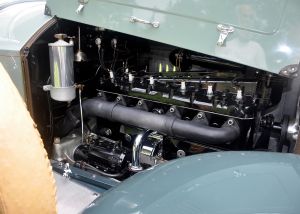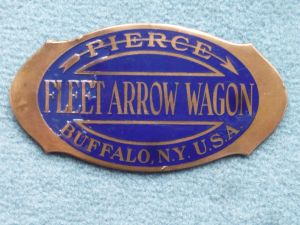- Home
- About Us
- Join/Renew
- Member Benefits
- Member Pages
- Log In
- Help
- Museum Store
Ken, Check also with Greg Long, I believe he has / makes an adapter and has the K&N filter info. George Teebay also might be able to help you with this. He had one on his S80 cars.
Peter, Thanks for trying, the dual valve 6 in my Series 36 has a completely different air intake setup than the Series 80/81 even though it is the same era. It has two air intakes, one with a cylindrical screen, the other comes through a passage that passes through the block from the right side below the exhaust manifold to the carb on the left side of the block. I think I am going to go through the K&N catalog and see if there is anything that will fit the opening in the block and possibly make an adapter. There are several simple solutions for the cylindrical screen, it is the other one that I am trying to figure out. It sounds like Ken could use your photos and information.
As a footnote: I am trying to gather information on modern air filter solutions for P-As to put together an article for a future PASB. If anyone has any solutions, please e-mail me any information and photos you might have. [email protected]
Thanks, Dave
Thanks Greg. Have you seen anything that would fit over the flat opening on the right side of the block?
Mark,
All of the above suggestions are good. Your idea of buying the PASB Disk is also good. It has all of the PAS service bulletins going back to the sixties. The latest (2018) PASBs are on the website for download. A lot of information on the disk, some factory service letters, some from knowledgeable PAS members (including some that worked for Pierce) and some Message Board threads. Like you, I prefer printed. I have printed all of the PASBs off the disk that pertain to my car and put them in a binder along with the appropriate section of the “Wiring and Tune up Guide” and the Owner’s Manual(that has a LOT of useful info). The disk is searchable using Adobe Acrobat. The trick to it is using the correct search phrase. Too specific you will get nothing, too general and you will get too many hits. It takes a little practice. This Message Board also has a search feature. The same caveat applies about the search phrase.
As previously mentioned, your Owner’s Manual is downloadable from the “Library” section on this website. The Parts Book and several sales books are listed and are available from the AACA library. Have fun with the new car.
Dave
The Series 36 also has a bypass oil filter that operates as Greg described above. It is the silver canister in the upper left of the photo. The element is replaceable with a farm equipment filter. I can dig up the part number if anybody needs it.
A good air filter is the bigger challenge on the Series 33/36 engines. There are two air intakes on the carb, one a round screen and one that comes into the side of the carb through the block from the right side of the engine below the exhaust manifold( the polished piece behind the water pump outlet pipe is the intake). Just to make it more challenging, there is also a water pipe that goes through the same opening (the valve visible below the air intake) plus some small holes for the water line on the carb side of it. As Paul Johnson referenced above, there also appears to be an opening inside the passage through the block that pulls crankcase air into the intake. So there are a lot of sources for air.
I have been trying to come up with something to filter the incoming air. The round screen could be wrapped, but coming up with something for the block intake is a little more challenging. I have thought about something very thin to go between the carb and the block, but it wouldn’t have much surface area and having to pull the carb loose every time I wanted to clean it would be a pain. If anybody has come up with a good air filter solution for the later dual valve 6’s, please post it. Dave

David, Nor Cal has been seeing a LOT of rain the last week including Sacramento. Several feet of snow in the mountains. Sun is forecast for next week though. We’re sending all of storms to the east, so probably more headed your way…….. Dave
Paul, Where do the fumes get drawn into the intake air? Inside the block, where the warmed air goes through the block from the right side of the block to the carb on the left? -Dave
This might work even better if you can figure out how to get it home……..
Taken at the PAS 2017 meet in St. Louis.
Welcome to the PAS and congratulations on the “new”” car. We’d love to see your pictures.”
This distributor is very similar to, but not identical to, the distributors on my ’27 and ’28 Series 36 cars, which are Delco. Without having it in my hand to look at, it does look like it might fit. Perhaps an aftermarket distributor, an alternate manufacturer, or maybe from a late Series 33?
Tony, Thanks for offering to share. I’d be worried that electrocution might be an issue. Hope you had a good Christmas. Dave
Hi Greg, I hope you and Ken had a good Christmas. If that plow truck decides to stop working you are guaranteed of lots of snow…….. Dave
We should all be so lucky as to have to figure out how to get a “new” Pierce-Arrow down the chimney for Christmas. Great car Terry.
Tony, are you buried in snow yet?
Merry Christmas and Happy Holidays,
Dave and Donna
Great looking project. It looks like you are making good progress. Thanks for the photos. Dave
Charles, I found the photo on-line. I have a 1928 Series 36 that has the white emblem, I was curious about the Fleet Arrow Emblem, so I went looking. This was the only photo I found. Do you have the Fleet Arrow it goes on and can you post a picture of it?
When you post a picture, make sure the resolution is less than 1200 pixels or so on the long dimension. For some reason the website doesn’t like higher resolution photos.
Apparently a different emblem from the cars. Do a web search for Radiator Emblem Restoration and there are several companies that restore them. Sorry no recommendations one way or the other.
How about this one?

Charles,
This is the Radiator Emblem found only on 1928 P-A Series 36 and 81 cars. I don’t know if it is also on the Fleet Arrow. Is this what you have?

Scott,
PASB 2018-5 has an article on the 33-38 brake systems. It is available on the website in the members section under the “Service Bulletins” tab. Sorry, I don’t have any actual experience in using them. Dave
Richard,
According to the link below, front plates are not required on collector cars in Minnesota.
David,
There was a Message Board thread a while back about running Evapo Rust as coolant for a period of time to remove rust from inside the block without having to tear the engine down. Time and heat make it work better. The thread will be appearing as an article in the Service Bulletin shortly. Dave
Rich, Congratulations on the “new”” car. I’ll guess we’ll have to come up your way again to see it. Dave”
